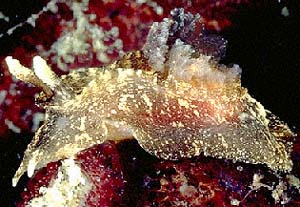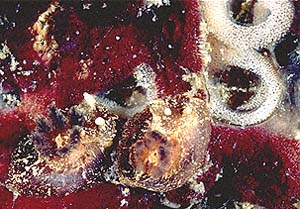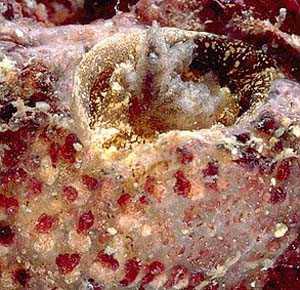
Goniodoris meracula
Burn, 1958
Order: NUDIBRANCHIA
Suborder: DORIDINA
Family: Goniodorididae
DISTRIBUTION
Southeastern Australia: From Pearson Island, South Australia to the mid New South Wales coast, from intertidal to 65m depth. [Burn [in] Shepherd & Thomas, 1989]
PHOTO
Sorrento Pier, Port Phillip Bay, Victoria, March 1986. Upper right - Whole animal crawling over ascidian colony. Lower left - Two animals on ascidian colony which has been torn open to show hidden egg ribbons. Lower right - An animal nestled in a burrow it has eaten out in the ascidian colony. Note foot folded up the walls of the burrow. Photos: Bill Rudman.
The body shape is typical for the genus with a high body and pointed tail. The edge of the mantle is extended into a very thin, narrow, rim-like flange, minutely crenulate and roughened, continuous all round the body except behind the gills. The oral tentacles are large, and the separate gills are arranged in a circlet around the anal papilla. The body is translucent with a mottled pattern of browns and white, the proportion of each varying in different specimens. From my notes on living animals I describe the colour as " Translucent body covered with dense specks of either dark rusty brown or creamy white. The colours are not uniform over the surface but in aggregations of one colour or the other giving a patchy brown and white appearance to the head, walls of the foot and tail. The dorsum is mostly brown-speckled with some small measure of white mottling. The rhinophore stalks are almost entirely brown while the clubs are predominantly white but with a lot of brown patching. The gills are similar in colour to the rhinophores, only the very distal tips having any white speckling. From the base of each gill there is a ridge running to the anus, the ridges appearing as spokes of a wheel whose hub is the anus. It grows to approximately to 20 mm in length.
Animals are usually found associated with colonial acidians. They usually feed by burrowing into the colony, forming a hole not much larger than the slug. The foot is usually folded up the sides of the hole so the slug's body is effectively surrounded by its own foot. In some instances the exit/entrance hole in the ascidian colony is smaller than the slug, suggesting that it has grown in size since entering the ascidian colony. In these cases the slug is almost invisible from the outside. The most obvious indication of the slug's presence are its egg ribbons which it deposits on the ascidian usually around the entrance to its burrow, but sometimes inside the burrow.
Reference:
• Burn, R.F. (1958). Further Victorian Opisthobranchia. Journal of the Malacological Society Australia, 1(2): 20-36, pls. 6-7.
• Burn, R. (1989). Opisthobranchs, in Shepherd, S.A. & Thomas, I.M. Marine Invertebrates of Southern Australia, Part II. South Australian Government Printing Division, Adelaide. 900 pages


Rudman, W.B., 2003 (September 3) Goniodoris meracula Burn, 1958. [In] Sea Slug Forum. Australian Museum, Sydney. Available from http://www.seaslugforum.net/factsheet/gonmerac
Related messages
-
Goniodoris meracula from southeastern Australia ?
From: Andrew Newton, April 7, 2008 -
Goniodoris meracula from S.E. Australia
From: John Chuk, September 2, 2003 -
Goniodoris meracula - egg ribbons
From: Rachel Przeslawski, September 1, 2003 -
Eggs of Goniodoris meracula
From: Kirsten Benkendorff, April 8, 1998
